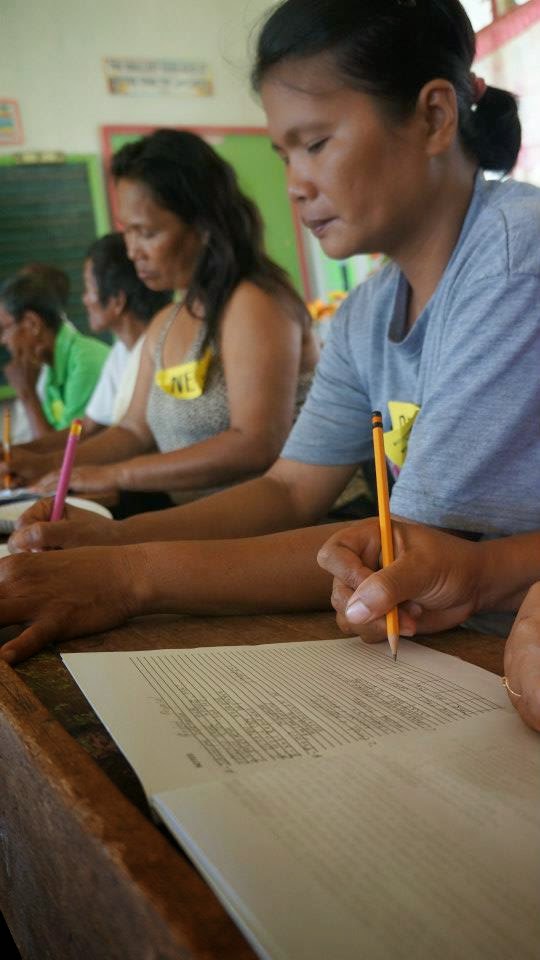During the primary survey
conducted last October 2011, data showed that only 47% households have access to sanitary toilet
facilities. The following reasons have been revealed during the initial
assessment of households:
1.
Lack of awareness on effects of
unsanitary toilet facilities
2.
Inadequate communication
strategies to promote use of sanitary toilet facilities
3.
Lack of programs targeting toilet
sanitation
4.
Lack of political will to address
issues on sanitation
5.
Cultural barriers continue to
exist in 35% of the households in the community
In collaboration with identified
key persons from the community, the team was able to formulate a comprehensive
health plan with the objective of increasing
the number of households with access to sanitary toilet facilities from 47% to
75% by the year 2015 consistent with Millenium Development Goal which targets
to halve the proportion of people without sustainable access to sanitation by
2015.
Sanitation is defined as the safe disposal of human excreta and associate
hygiene promotion. A safe toilet accompanied by handwashing with soap provides
an effective barrier to transmission of diseases.
Each of the following sanitation facility type is considered basic
sanitation for monitoring progress toward household sanitation targets.
·
If the facility is shared among no
more than 5 families or 30 persons, whichever is fewer and if the users know
each other
·
A pit latrine with a
superstructure and a platform or squatting slab constructed of durable material
including pour-flush latrines, ventilation improved pit latrines (VIP), pit
latrine with slab
·
A flush toilet connected to a
septic tank, other depository or a sewer
PROPOSED SOLUTIONS
Toilet
adoption comes from providing the appropriate toilet design, nurturing
community involvement and ownership of the problem, encouraging collaborations with
the local leaders and stakeholders from the community and more importantly,
understanding people’s ideas and values around sanitation. (Devine, 2009)
With
this in mind, conceptualization of strategies for sustainable sanitation was
created, which were the guiding principles of this project.
Breaking the Cycle of Cultural Barriers:
·
Identifying
cultural practices: assessment of cultural influences on toilet adoption
·
Bridging
leadership training with local leaders through self-awareness leadership training
(SALT)
Mrs. Rubinos, then a 4Ps Parent Leader and Mrs. Ganob, Barangay Health Worker, taking notes during the leadership training
Orientation of Identified Key Persons from the community during a Communication Exercise
Team Mauswagong Mirangan attempting to reach the remote area of the barangay for primary health survey, October 2011
Primary Health Survey with Mrs. Silao, Barangay Nutrition Scholar, and members of the barangay council and health team
BNS accompanies Medical Student during the survey activities
Child
Education: (children as promoters of good hygiene practices at home)
·
Launching
of Global Hand Washing Day: Health education on hand washing
·
Stage
Play: “Diarrhea Monster”
A shot taken during the play entitled Diarrhea Monster
Diarrhea takes the life of thousands of children annually. Increasing awareness of its prevention can make a difference in the lives of these children.
Global Handwashing Day celebration, October 2014
Handwashing Promotion during Global Handwashing Day Celebration, October 2014
Global Handwashing Day celebration, October 2012
Toilet
Construction
·
Engaged
social contract (Goal: One Toilet, One Household)
·
Solicit
Sanitary Inspector advice on toilet construction
·
Construction
design - culturally appropriate
·
Construction
Phase –Bayanihan approach: A Filipino value
Head of Household signing a written agreement to support sanitation campaign by agreeing to construct toilet facility for a safer, healthier community.
Mr. Albano, Sanitary Inspector talks about the importance of sanitary toilet facilities during a Family Development Seminar
Locally Available Materials used for construction of toilet facilities
Newly constructed toilet facility for sustainable sanitation
Pour-Flush Toilets or water-seal type of toilets with less water required for flushing help increase toilet adoption in communities with problematic water supply
Toilet Construction at Purok 3
Monitoring
·
Establish
Guidelines for Assessing Toilet Sanitation
Sustainable
Sanitation
·
Establish
a sanitation surveillance team
·
Creation
of Local Ordinances to promote use of sanitary toilet facilities
Fostering political will through creation of written policies
Involvement of the stakeholders from the community proved to be an essential step towards achieving the goal of increasing percentage of households with access to basic sanitation
Monitoring of household's access to basic sanitation using a Sustainable Sanitation Criteria
Sanitation Surveillance Team in action, March 2013
SUSTAINABILITY
Local leadership training of key persons
identified provided an avenue for potentials to be realized and fresh ideas to
be explored. Core group members were given the opportunity to exercise their
leadership skills when the medical students gave them full responsibility in
organizing events in the community. Action plans discussed during the previous
years included plans for health education activities and monitoring of target
households, these were implemented according to the pace set by the core group members.
Their decision-making skills have been honed by years of experience in the
community and their local influence has been beneficial in a multitude of
sanitation campaigns and health promotion activities, proving that this unit
can help mobilize the community even after the completion of the community
immersion.
Construction
of toilet facilities by target households in the beginning was difficult to
promote, however, a steady increase in toilet adoption was observed during the
years that followed. Nurturing community ownership of the problem coupled with
behavior change communication proved to be effective in this community. As
households began constructing their sanitary toilet facilities, they have
assumed ownership of the program itself, placing value on hard work by peers
and neighbors willing to help construct such a structure and encouraging other
neighbors to do the same.
Written
policies and regulations mandated by the legislative body of the community was
the final step in the programs for toilet sanitation in hopes of reinforcing a
sustainable sanitation program implemented in the community.
From
2011 – 2015 there have been changes in the behavior of the residents at
Barangay Mirangan when it comes to sanitation. As shown in the figure above,
the number of households with access to sanitary toilet facilities has steadily
increased in the past three years, from 47 percent to 80 percent exceeding the
hoped for target of 75 percent.
Nurturing
community involvement and ownership of the problem, collaborations with the
local leaders and stakeholders from the community and more importantly,
understanding people’s ideas and values around sanitation helped in increasing
toilet demand and therefore toilet adoption in the community.






















No comments:
Post a Comment